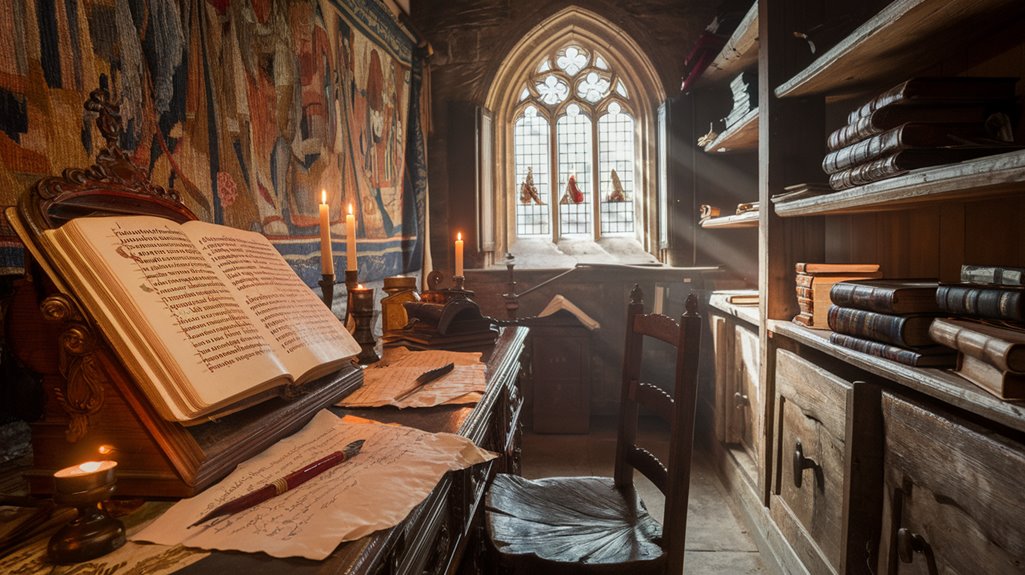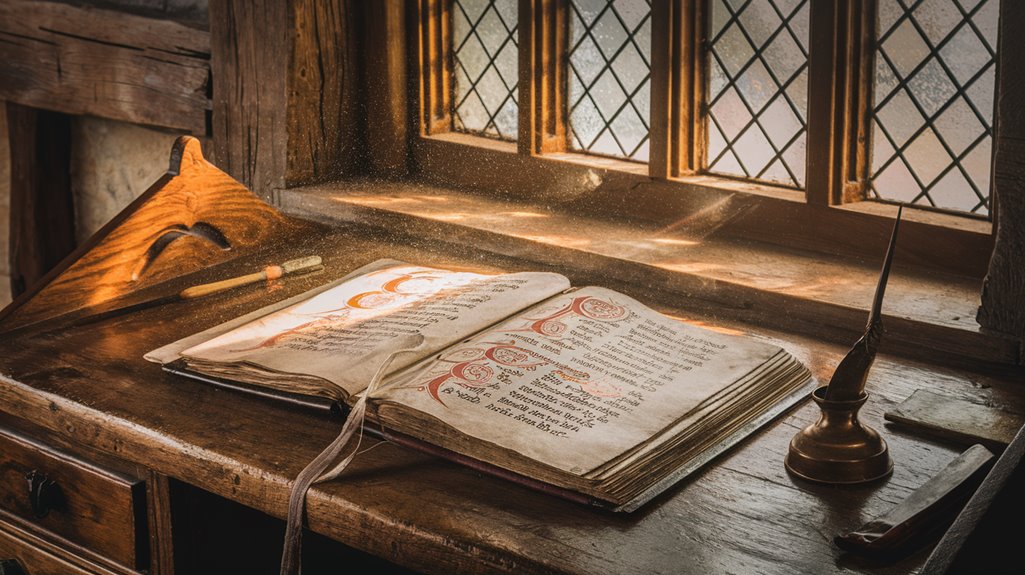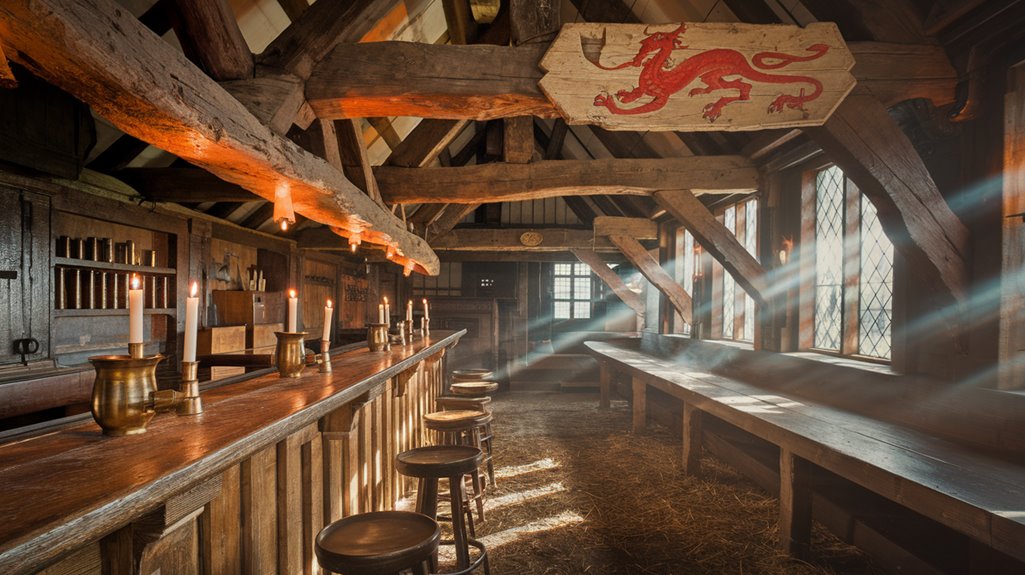How Far Back Could You Go and Still Speak English?
While you might assume that English hasn't changed much over time, you'd be surprised by how quickly you'd struggle to communicate if you traveled back through history. Though you can easily understand Shakespeare's plays with some guidance, you'd find yourself lost in conversation just a few centuries before that. The fascinating evolution of English reveals distinct turning points that mark where you could – and couldn't – make yourself understood to your ancestors.
The Time Traveler's Guide to English Communication

While you might dream of conversing with Shakespeare or Chaucer, communicating with English speakers from different time periods would be far more challenging than you'd expect. The language has undergone dramatic transformations, particularly through the Great Vowel Shift of the 15th and 16th centuries, which radically altered pronunciation patterns. Old Norse words enriched the language vocabulary following the Viking invasions.
Even if you traveled just a few centuries back, you'd encounter significant dialect diversity across different regions of England. Four distinct dialects dominated Old English: Mercian, Northumbrian, Kentish, and West Saxon. The lack of standardized spelling before the printing press would compound your communication challenges.
Beyond pronunciation challenges, you'd need to navigate complex cultural differences and social norms. Understanding the local customs and etiquette would be just as important as grasping the language itself. The further back you'd go, the more foreign English would become, until it'd be virtually unrecognizable before the Middle English period.
Understanding Modern English Speakers in History
Although you might understand Shakespeare's written words with some effort, speaking with English speakers from different historical periods would require varying levels of adaptation.
The language evolution from Early Middle English to Modern English presents significant challenges, particularly due to the Great Vowel Shift and the blending of various linguistic influences.
You'd find that dialect diversity compounds these difficulties, as regional variations across England and beyond created distinct ways of speaking.
Before the 7th century, reading would have been especially challenging since spaces between words didn't exist in written text.
Even if you traveled back to the 15th century, you'd encounter a complex mix of French and Old English vocabulary that might sound foreign to your modern ears.
The cultural barriers would further complicate your interactions, as social norms, religious beliefs, and living conditions were drastically different from today's standards.
The Norman Conquest of 1066 dramatically transformed the English language, introducing Norman French vocabulary that became deeply embedded in the language of nobility and government.
Key Language Shifts Through the Centuries
Throughout English's evolution, major language shifts have transformed it from an obscure Germanic dialect into today's global lingua franca.
You'd find Old English emerging around 700 AD, shaped by Germanic dialects and written first in runes, then in Latin script. After the Norman Conquest in 1066, Middle English developed, blending Norman French with Germanic roots.
The language underwent dramatic changes during the Great Vowel Shift from the 14th to 16th centuries, considerably altering pronunciation while spelling remained relatively stable. Chancery English standard was established by government clerks in the mid-1400s, helping to formalize written English.
London's dialect became increasingly influential, especially with the advent of printing. By the 17th century, distinct variations like American and British English began to emerge.
Through colonization and later globalization, English spread worldwide, incorporating countless foreign words and developing diverse regional dialects.
The Norman Impact on English Comprehension
Since the Norman Conquest in 1066, French influence dramatically transformed English comprehension for centuries to come.
If you'd traveled back to medieval England, you'd find the nobility speaking French while commoners used English, creating a significant language divide. After King John lost Normandy in 1214, French came to be seen as more provincial. The Norman vocabulary infiltrated every aspect of society, from government and law to art and literature, with over 10,000 French words becoming part of English.
During this period, core family terms remained Germanic while French words were adopted for more complex social relationships. You'd notice that French influence reshaped English so thoroughly that today's English shares substantial vocabulary with Romance languages. Words like "royal," "coronation," and "university" entered common usage, and new hybrid terms emerged by combining French and English elements.
This transformation was so profound that if you ventured before the Norman Conquest, you'd likely struggle to understand Old English at all.
Old English: A Foreign Language to Modern Ears

If you think understanding post-Norman English would be challenging, trying to comprehend Old English would feel like encountering a completely foreign language. The linguistic challenges you'd face go beyond simple vocabulary differences, as Old English operated with complex grammar rules and an entirely different pronunciation system.
Old English evolved from the languages of Germanic tribal settlers, who brought their dialects to Britain in the 5th century. Approximately 85 percent of its vocabulary is no longer used in modern English.
Here's why you'd struggle to communicate with your Anglo-Saxon ancestors:
- The language used five distinct cases and three genders for nouns.
- Word order was much freer due to extensive inflectional endings.
- Pronunciation barriers arose from the Great Vowel Shift.
- Vocabulary differences exist even in common words that survived.
Despite sharing about 50% of modern English's core vocabulary, Old English's structure and sound system would make it virtually incomprehensible to your modern ears, requiring extensive study to master.
Bridging Historical Language Gaps Today
While the challenges of understanding historical English may seem intimidating, modern educators and linguists have developed innovative approaches to bridge these linguistic gaps.
The increasing emphasis on globalization has made understanding language evolution more critical than ever.
You'll find a blend of traditional methods, like the ancient Chinese fan-qie system, now integrated with modern technology to improve English pronunciation and comprehension. The system influenced Stalling to select 42 Chinese characters that could represent English sounds effectively.
Cultural exchange plays a crucial role through "boundary spanners" who facilitate cross-linguistic communication, while vocabulary strategies leverage cognates and multimedia tools to build language skills effectively.
You can even experience artistic expression bridging these gaps, as demonstrated by Jonathan Stalling's opera Yingelishi, which creatively uses Chinese characters to represent English sounds.











